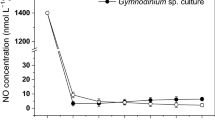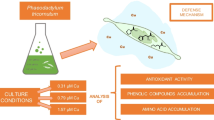Abstract
Recent studies demonstrated that the toxic red tide phytoplankton Chattonella spp. produce activated oxygen species such as superoxide anion (O -2 ), hydrogen peroxide (H2O2), and hydroxyl radicals (·OH), which may be responsible for the toxicity of this flagellate. However, the mechanism behind the production of these oxygen radicals and H2O2 by Chattonella spp. is largely unknown, and the physiological significance of activated oxygen species for Chattonella spp. is also unclear. In the present study, we investigated the involvement of iron in the generation of O -2 and H2O2 by C. marina. The generation of O -2 by C. marina was related to the growth phase; the highest rate of O -2 production was observed during the exponential growth phase. However, no such increase during the exponential growth phase was observed in C. marina growing in an iron-deficient medium, even though the growth of C. marina was not significantly affected by iron-deficiency during the first 4 d. In addition, the iron chelator desferrioxamine (Desferal) strongly inhibited the generation of both O -2 and H2O2 by C. marina in a concentration-dependent manner. The growth of C. marina was also inhibited by Desferal. Furthermore, in the presence of 500 μM Desferal, C. marina-induced growth inhibition of the marine bacteria Vibrio alginolyticus was almost completely abolished. These results suggest that iron is required for the generation of activated oxygen species by C. marina, as well as for its own growth.
Similar content being viewed by others
References
Alcain FJ, Löw H, Crane FL (1994) Iron at the cell surface controls DNA synthesis in CCI 39 cells. Biochem biophys Res Commun 203: 16–21
Asada K, Kiso K, Yoshikawa K (1974) Univalent reduction of molecular oxygen by spinach chloroplasts on illumination. J biol Chem 249: 2175–2181
Asada K, Takahashi M (1987) Production and scavenging of active oxygen in photosynthesis. In: Kyle DI, Osmond CR, Arntzen CJ (eds) Photoinhibition. Elsevier Science Publishers BV, Amsterdam, New York, Oxford, pp 227–286
Babior BM (1978) Oxygen-dependent microbial killing by phagocytes. New Engl J Med 298: 721–725
Babior BM, Curnutte JT, McMurrich BJ (1976) The particulate superoxide-forming system from human neutrophils. Preperties of the system and further evidence supporting its participation in the respiratory burst. J clin Invest 58: 989–996
Bienfait HF (1985) Regulated redox processes at the plasmalemma of plant root cells and their function in iron uptake. J Bioenerg Biomembr 17: 73–83
Brightman A, Barr R, Crane FL, Morré DJ (1988) Auxin-stimulated NADH oxidase purified from plasma membrane of soybean. Pl Physiol 86: 1264–1269
Cakmak I, Marschner H (1988a) Enhanced superoxide radical production in roots of zinc-deficient plants. J exp Bot 39: 1449–1460
Cakmak I, Marschner H (1988b) Zinc-dependent changes in ESR signals, NADPH oxidase and plasma membrane permeability in cotton roots. Physiologia Pl 73: 182–186
Cakmak I, Van de Wetering DAM, Marschner H, Bienfait HF (1987) Involvement of superoxide radical in extracellular ferric reduction by iron-deficient bean roots. Pl Physiol 85: 310–314
Dean RT (1987) Free radicals, membrane damage and cell-mediated cytolysis. Br J Cancer 55: 39–45
DiTullio GR, Hutchins DA, Bruland KW (1993) Interaction of iron and major nutrients controls phytoplankton growth and species composition in the tropical North Pacific Ocean. Limnol Oceanogr 38: 495–508
Doke N (1985) NADPH-dependent O -2 generation in membrane fractions isolated from wounded potato tubers inoculated with Phytophtora infestans. Physiol molec. Pl Pathol 27: 311–322
Elstner EF (1982) Oxygen activation and oxygen toxicity. A Rev Pl Physiol 33: 73–96
Endo M, Sakai T, Kuroki A (1985) Histological and histochemical changes in the gills of the yellowtail Seriola quinqueradiata exposed to the Raphidophycean flagellate Chattonella marina. Mar Biol 87: 193–197
Fridovich I (1986) Biological effects of the superoxide radical. Archs Biochem Biophys 247: 1–11
Gross DG, Jane C, Elstner EF (1977) Involvement of mallet, monophenols, and the superoxide radical in hydrogen peroxide formation by isolated cell walls from horse radish (Armoracia lapathifolia Gilib.). Planta 136: 271–276
Halliwell B, Gutteridge JMC (1984) Oxygen toxicity, oxygen radicals, transition metals and disease. Biochem J 219: 1–14
Ishimatsu A, Maruta H, Tsuchiyama T, Ozaki M (1990) Respiratory, ionoregulatory and cardiovascular responses of the yellowtail Seriola quinqueradiata to exposure to the red tide plankton Chattonella. Nippon Suisan Gakk 56: 189–199
Ishimatsu A, Sameshima M, Tamura A, Oda T (1996) Histological analysis of the mechanisms of Chattonella-induced hypoxemia in yellowtail. Fish Sci 62: 50–58
Ishimatsu A, Tsuchivama M, Yoshida M, Sameshima M, Pawluk M, Oda T (1991) Effect of Chattonella exposure on acid-base status of the yellowtail. Nippon Suisan Gakk 57: 2115–2120
Johnson KJ, Fantone JC, Kaplan PA (1981) In vivo damage of rat lungs by oxygen metabolites. J clin Invest 67: 983–993
Johnston RB, Godzik CA Jr, Cohn ZA (1978) Increased superoxide anion production by immunologically activated and chemically elicited macrophages. J exp Med 148: 115–127
Kakinuma K, Minakami S (1978) Effects of fatty acids on superoxide radical generation in leukocytes. Biochim biophys Acta 538: 50–59
Klebanoff SJ (1982) Oxygen-dependent cytotoxic mechanisms of phagocytes. In: Gallin JI, Fauci AS (eds) Advances in host defense mechanisms. Raven Press, New York, pp 111–162
LaMont JT (1989) Oxygen radicals stimulate gallbladder glycoprotein secretion. In: Chantler E, Ratcliffe A (eds) Mucus and related topics. The Company of Biologists Ltd, Cambridge, pp 273–278
Matsusato T, Kobayashi H (1974) Studies on death of fish caused by red tide. Bull Nansei reg Fish Res Lab 7: 43–67 (in Japanese with English abstract)
McCord JM, Fridovich I (1969) Superoxide dismutase. J biol Chem 244: 6049–6055
Menasche P, Grousset C, Granduel J, Mouas C, Piwnica A (1987) Prevention of hydroxyl radical formation: a critical concept for improving cardioplegia. Protective effects of deferoxamine. Circounc cardiovas Surg, Am Heart Ass 76: 180–185
Møller IM, Lin W (1986) Membrane-bound NAD(P)H dehydrogenases in higher plant cells. A Rev Pl Physiol 37: 309–334
Nakamura Y, Watanabe M (1983) Growth characteristics of Chattonella antiqua. Part 2. Effects of nutrients on growth. J oceanogr Soc Japan 39: 151–155
Nathan CF, Root RK (1977) Hydrogen peroxide release from mouse peritoneal macrophages. J exp Med 146: 1648–1662
Oda T, Akaike T, Hamamoto T, Suzuki F, Hirano T, Maeda H (1989) Oxygen radicals in influenza-induced pathogenesis and treatment with pyran polymer conjugated SOD. Science, NY 244: 974–976
Oda T, Akaike T, Sato K, Ishimatsu A, Takeshita S, Muramatsu T, Maeda H (1992a) Hydroxyl radical generation by red tide algae. Archs Biochem Biophys 294: 38–43
Oda T, Ishimatsu A, Shimada M, Takeshita S, Muramatsu T (1992b) Oxygen-radical-mediated toxic effects of the red tide flagellate Chattonella marina on Vibrio alginolyticus. Mar Biol 112: 505–509
Oda T, Ishimatsu A, Takeshita S, Muramatsu T (1994) Hydrogen peroxide production by the red-tide flagellate Chattonella marina. Bosci Biotech Biochem 58: 957–958
Oda T, Morinaga T, Maeda H (1986) Stimulation of macrophage by polyanions and its conjugated protein and effect on cell membrane. Proc Soc exp Biol Med 81: 9–17
Oda T, Moritomi J, Kawano I, Hamaguchi S, Ishimatsu A, Muramatsu T (1995) Catalase- and superoxide dismutase-induced morphological changes and growth inhibition in the red tide phytoplankton Chattonella marina. Biosci Biotech Biochem 59: 2044–2048
Onoue Y, Nozawa K (1989) Separation of toxins from harmful red tides occurring along the coast of Kagoshima prefecture. In: Okaichi T, Anderson DM, Nemoto T (eds) Red tides: biology, environmental science, and toxicology. Elsevier, New York, pp 371–374
Oren R, Farnham AE, Saito K, Milfosky E, Karnovsky ML (1963) Metabolic patterns in three types of phagocytizing cells. J Cell Biol 17: 487–501
Romeo D, Zabucchi G, Rossi F (1973) Reversible metabolic stimulation of polymorphonuclear leukocytes and macrophages by concanavalin A. Nature new Biol 243: 111–112
Sakai T, Yamamoto K, Endo M, Kuroki A, Kumanda K, Takeda K, Aramaki T (1986) Changes in the gill carbonic anhydrase activity of fish exposed to Chattonella marina red tide, with special reference to the mortality. Bull Jap Soc scient Fish 52: 1351–1354
Senaratna T, Mckersie B, Borochov (1987) Desiccation and free radical mediated changes in plant membranes. J exp Bot 197: 2005–2014
Shimada M, Kawamoto Y, Nakatsuka Y, Watanabe M (1993) Localization of superoxide anion in the red tide alga Chattonella antiqua. J Histochem Cytochem 41: 507–511
Shimada M, Murakami TH, Imahayashi T, Ozaki HS, Toyoshima T, Okaichi T (1983) Effects of sea bloom, Chattonella antiqua, on gill primary lamellae of the young yellowtail, Seriola quinqueradiata. Acta histochem cytochem 16: 232–244
Shimada M, Nakai N, Goto H, Watanabe M, Watanabe H, Nakanishi M, Yoshimatsu S, Ono C (1991) Free radical production by the red tide alga, Chattonella antiqua. Histochem J 23: 362–365
Shimada M, Shimono R, Murakami TH, Yoshimatsu S, Ono C (1989) Red tide, Chattonella antiqua reduces cytochrome c from horse heart. In: Okaichi T, Anderson DM, Nemoto T (eds) Red tides: biology, environmental science, and toxicology, Elsevier, New York, pp 443–446
Tanaka K, Muto Y, Shimada M (1994) Generation of superoxide anion radicals by the marine phytoplankton organism, Chattonella antiqua. J Plankton Res 16: 161–169
Tanaka K, Yoshimatsu S, Shimada M (1992) Generation of superoxide anions by Chattonella antiqua: possible causes for fish death by “Red Tide”. Experientia 48: 888–890
Thompson JE, Legge RL, Barber RF (1987) The role of free radicals in senescence and wounding. New Phytol 105: 317–344
Tsuchivama T, Ishimatsu A, Oda T, Uchida S, Ozaki M (1992) Effect of Chattonella exposure on plasma catecholamine levels in the yellowtail. Nippon Suisan Gakk 58: 207–211
Vianello A, Macrì F (1989) NAD(P)H oxidation elicits anion superoxide formation in radish plasmalemma vesicles. Biochim biophys Acta 980: 202–208
Vianello A, Macrì F (1991) Generation of superoxide anion and hydrogen peroxide at the surface of plant cells. J Bioenerg Biomembr 23: 409–423
Vianello A, Zancani M, Macr F (1990) Hydrogen peroxide formation and iron ion oxidoreduction linked to NADH oxidation in radish plasmalemma vesicles. Biochim biophys Acta 1023: 319–324
Yamaguchi K, Ogawa K, Takeda N, Hashimoto K, Okaichi T (1981) Oxygen equilibria of hemoglobins of cultured sea fishes, with special reference to red tide-associated mass mortality of yellowtail. Bull Jap Soc scient Fish 47: 403–409
Author information
Authors and Affiliations
Additional information
Communicated by T. Ikeda, Hakadate
Rights and permissions
About this article
Cite this article
Kawano, I., Oda, T., Ishimatsu, A. et al. Inhibitory effect of the iron chelator desferrioxamine (Desferal) on the generation of activated oxygen species by Chattonella marina . Marine Biology 126, 765–771 (1996). https://doi.org/10.1007/BF00351343
Received:
Accepted:
Issue Date:
DOI: https://doi.org/10.1007/BF00351343




